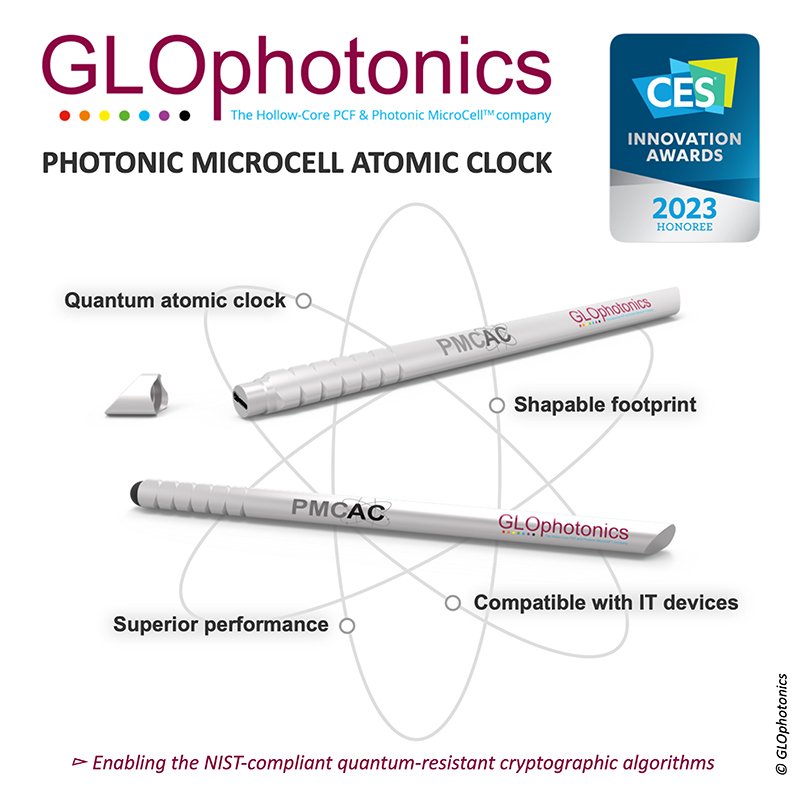

GLO is very proud to announce that its Photonic-MicroCell-Atomic-Clock (PMCAC) won the Innovation Award Honoree CES 2023. Its fiber micro-photoincs technology coupled with its compact, shapeable form will allow GLO to bring laboratory-level atomic clock performance into the pocket of any end-user.
Precision time-keeping has become the vital center of our modern economy, its overarching impact only equaled with the near-impossibility to grasp its vital and ubiquitous significance – strategic fields such as cyber-security, geopositioning, secured-telecommunications and agile compact and distributed sensors being only a few representative examples. At its heart is the atomic-clocks whose capabilities allow precision time-keeping to withing 10 micro-seconds every 3 millennia – representing one of the most remarkable demonstration of human achievement. However, their size and complexity has become a hindrance to their accessibility and deployment in every strategic sector. The craving for this performance to be brought in miniature devices is as pervasive as pressing, highlighted by the high profile accorded to compact atomic clocks at the major international programs like DARPA, and by the trillion-dollar market-size.
The fundamentals of atomic clocks consist of an electromagnetic signal, from e.g. a laser or a microwave source, interacting with the electrons around an atom, causing them to transition orbital to another. These transitions occur at precise, reproducible frequencies, unique to each atomic element and consistent throughout the entire universe – offering a universal, standardized reference for time. This allows atomic clocks to achieve performances far superior to mechanical clocks. Present day atomic clocks can be split into two categories:
- Research grade clocks offering phenomenal performances but can not be operated outside dedicated laboratories and occupying entire rooms, and
- miniaturized, chip-scale devices that suffer from limited precision and a strong frequency drifts.
PMCACs stand out from existing atomic clock technologies by their ability to confine light and atoms withing small areas and over long interaction lengths, allowing unprecedented Signal-to-Noise ratios (SNR) and consequently a time-keeping ability of not-losing-nor-gaining 1 millisecond in a millennium – more than 100 times better than any existing miniature clocks.
PMCACs are based on GLO’s proprietary Photonic MicrocellTM technology which is a length of micro-structured hollow core optical fiber filled with gas or vapor in a controlled and sealed fashion – earning them the qualification of “World smallest gas cell” (Nature 434 (7032))
The creation of miniaturized atomic clocks call for radical approaches compared to the lab-based atomic clocks as the high atom-light interactions need to be protected from various noise sources. This is particularly true with regard of confining atoms within micro-structures. Indeed, whilst the main frequency standards are based on spectral lines provided by a well identified list of atomic vapours (e.g. microwave hyperfine transitions of Cs or Rb), their tight confinement in micro-photonic structure is much less trivial. Furthermore, the extreme physio-chemical reactivity of most of these vapours makes their loading and trapping in a micronic package the first sine-qua-none condition to satisfy before any further developments are considered. GLO’s HCPCF and PMC technology has now surpassed these hurdles by creating a novel micro-structured glass photonic fiber platform with a hollow core whose inner-wall is made of a smart coating to protect the enclosed atoms and enhance their performance as atomic clocks. Furthermore, GLO’s R&D team is continuously working with the academic word to push the capability of its PMC technology even further as demonstrated by its partnership in the European project Cryst3.
In one of its many shapeable forms, the PMCAC comes as a pen-shaped instrument, similar to the pencil of a mobile phone, and connectable to any mobile device via common connectors such USB-connector and can be powered by the pile rechargeable by the device it connects to. It can be operated from any mobile phone, computer or instrument with IT connections, sending its high-precision clock-signal for geopositioning and navigation as well as a host of future applications. The PMCAC can be provided directly to the market as stand-alone add-on for positioning and navigation, or as a B2B product or OEM components for imbedded solutions in sensing, mining and precision instrumentation markets. The PMCAC’s core technology can be easily extended to a large range of quantum sensors and offers a highly competitive eco-footprint. Importantly for secured telecommunications, PMCAC has all the credential for enabling NIST-compliant Quantum-Resistant Cryptographic Algorithms. GLO is open to partner with leading players in the field of quantum sensing and quantum information and share with them the outstanding key enabling power of its PMC technology.
